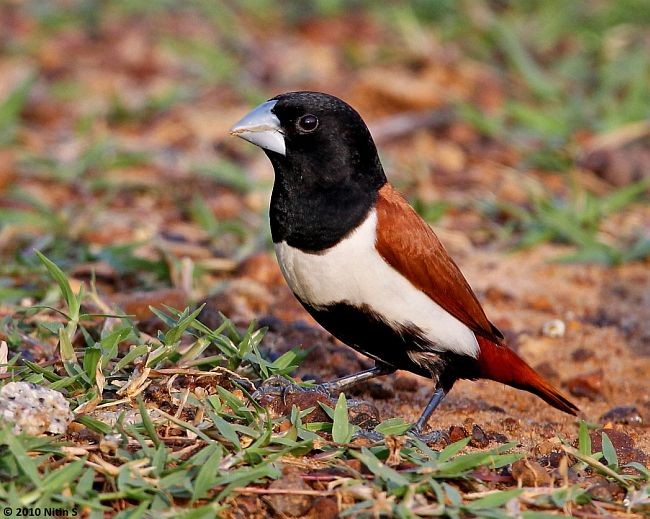Birdfinding.info ⇒ Locally common and apparently increasing in its natural range. Strongly associated with marshes and dense stands of tall grass. It can be found in several of India’s major metropolitan areas, including Mumbai, Kolkata (at Rajarhat), Goa, Bangalore, and Chennai. In Middle America, it is locally common to abundant in Mexico’s Usumacinta marshes, around Spanish Lookout in Belize, and around San Pedro Sula in Honduras.
Tricolored Munia
Lonchura malacca
Native to the Indian subcontinent; introduced in the Americas. Inhabits marshes and lush grasslands of central and southern India from Gujarat, Madhya Pradesh, Chhattisgarh, and Odisha south to Sri Lanka. In recent decades its range has expanded north locally to Punjab, Nepal, and Bangladesh.
In the Americas, introduced populations are established locally and expanding: from eastern Mexico (southern Veracruz through the Yucatán) to western Panama; in the West Indies on Cuba, Jamaica, Hispaniola, Puerto Rico, and Trinidad; and in three areas of northwestern South America: northern Venezuela (Lake Maracaibo to Caracas and south into the Llanos), west-central Colombia (mainly the Cauca and Magdalena valleys), and western Ecuador.
Identification
A medium-sized munia with a very large, pale blue or whitish bill and distinctive, boldly tricolored plumage: black hood and belly, otherwise white underparts, and chestnut wings, back, and tail.
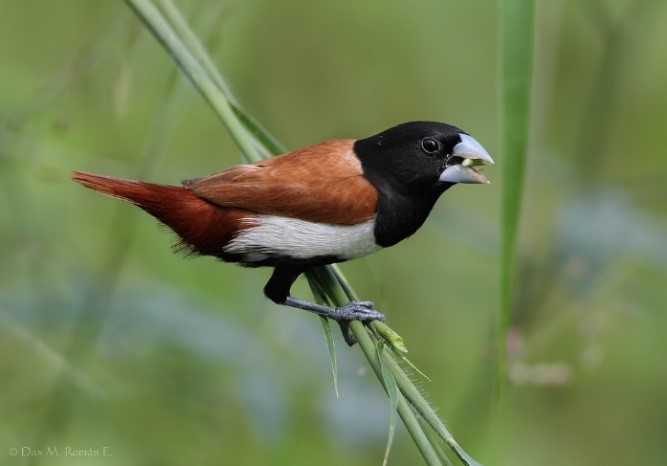
Tricolored Munia. (Cotui, Dominican Republic; December 12, 2012.) © Dax M. Román E.
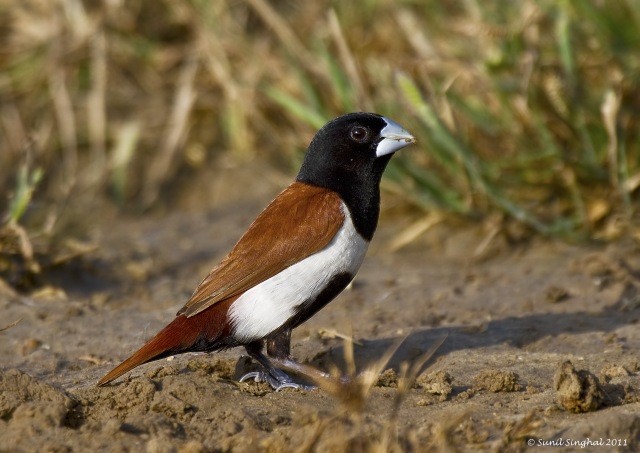
Tricolored Munia. (Abhera Wetland, Kota, Rajasthan, India; September 15, 2011.) © Sunil Singhal

Tricolored Munia. (Abhera Wetland, Kota, Rajasthan, India; October 13, 2012.) © Sunil Singhal
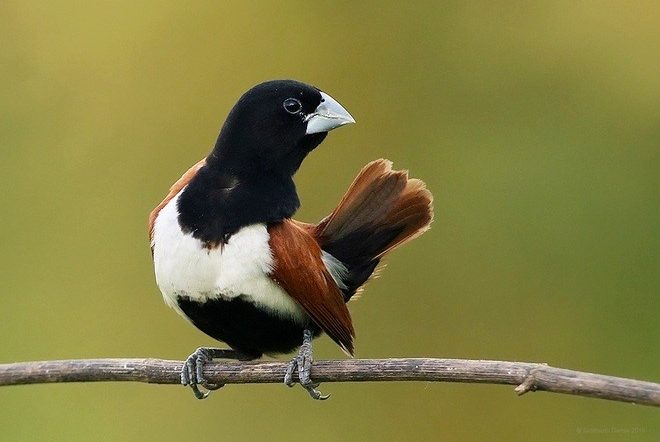
Tricolored Munia. (Chiplun, Ratnagiri, Maharashtra, India; September 16, 2018.) © Siddharth Damle

Tricolored Munia. (Akheraj Swamp, Jodhpur, Rajasthan, India; August 5, 2018.) © Vinod Puri Goswami

Tricolored Munia. (Bundala, Hambantota, Sri Lanka; November 13, 2012.) © Serala Jeevanthi

Tricolored Munia. (Surajpur Bird Sanctuary, Uttar Pradesh, India; November 9, 2014.) © Rajesh Kalra

Tricolored Munia. (Abhera Wetland, Kota, Rajasthan, India; October 12, 2016.) © Sunil Singhal
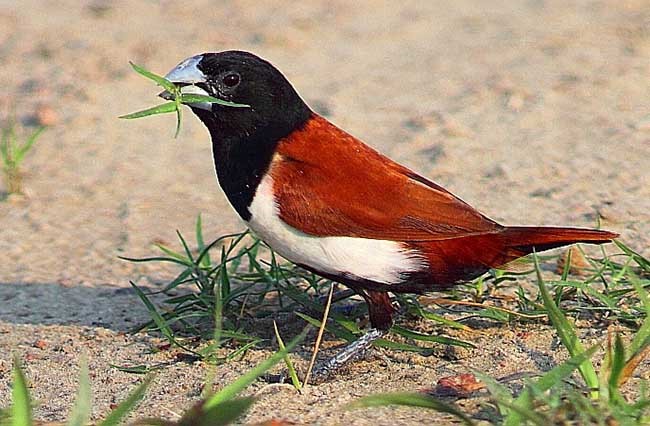
Tricolored Munia, showing a richly reddish tone on its upperparts. (Baruipur, South 24 Parganas, West Bengal, India; November 4, 2018.) © Prosenjit Singha Deo
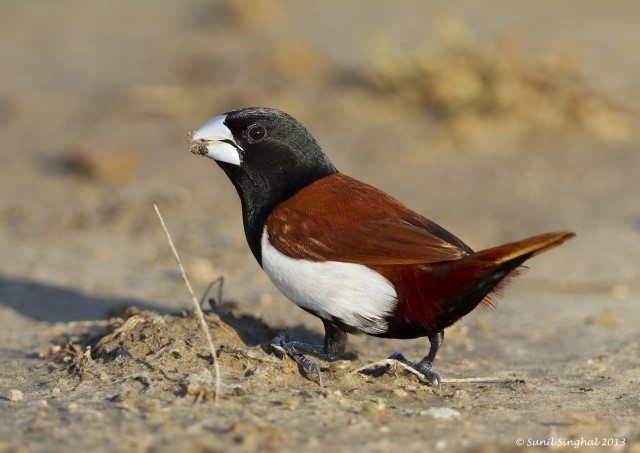
Tricolored Munia. (Abhera Wetland, Kota, Rajasthan, India; October 11, 2013.) © Sunil Singhal
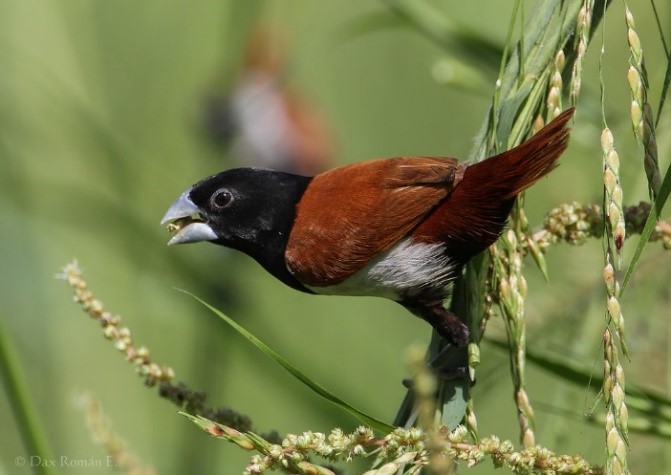
Tricolored Munia. (Cotui, Dominican Republic; December 12, 2012.) © Dax M. Román E.

Tricolored Munia. (Surajpur Bird Sanctuary, Uttar Pradesh, India; November 9, 2014.) © Rajesh Kalra
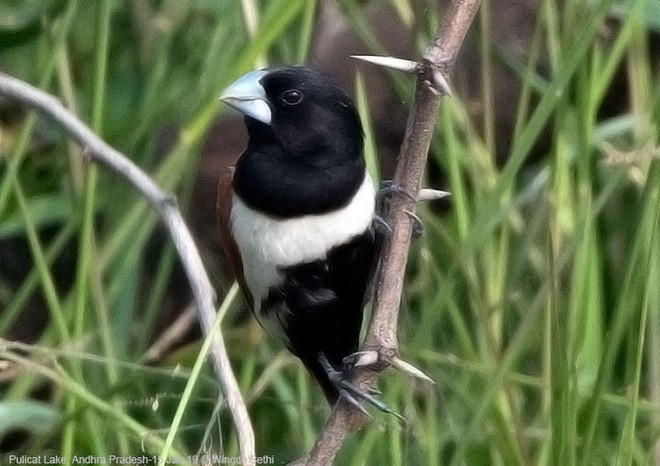
Tricolored Munia. (North Pulicat Lake, Andhra Pradesh, India; January 15, 2019.) © Vijay Kumar Sethi

Tricolored Munia. (Barasat, North 24 Parganas, West Bengal, India; August 18, 2013.) © Subrato Sanyal
A subset of the population shares the same pattern but with the white replaced by cream, yellow, cinnamon, rufous, or brown. Most of these birds appear to be natural variants of Tricolored, although some of the more rufous individuals strongly resemble Chestnut Munia and have been regarded as hybrids.

Tricolored Munia, buffy variant. (Barasat, West Bengal, India; November 2, 2013.) © Subrato Sanyal
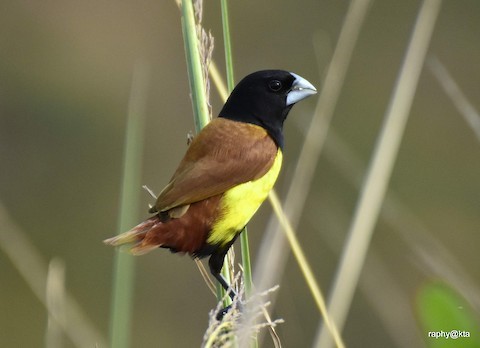
Tricolored Munia, yellow variant. (Kole Wetlands, Thrissur, Kerala, India; December 16, 2015.) © Raphy Kallettumkara

Tricolored Munia, cinnamon variant. (Barasat, North 24 Parganas, West Bengal, India; September 4, 2013.) © Subrato Sanyal
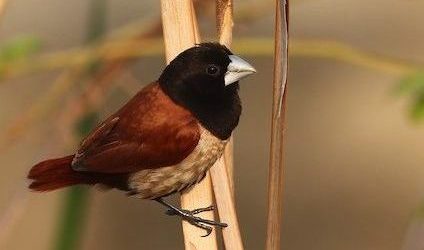
Tricolored Munia, cinnamon variant. (Ram Nagar Swamps, Madipakkam, Chennai, Tamil Nadu, India; December 20, 2018.) © Aravind AM

Tricolored Munia, brown variant. (Baruipur, South 24 Parganas District, West Bengal, India; November 25, 2018.) © Sumit Sengupta
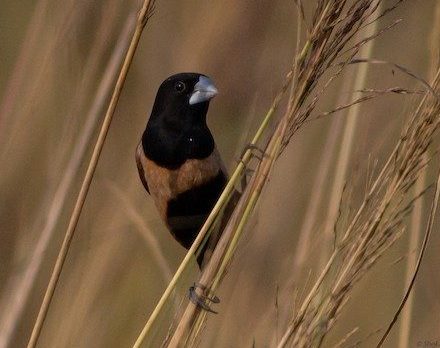
Tricolored Munia, brown variant. (Rajarhat, North 24 Parganas, West Bengal, India; October 27, 2018.) © Shekar Vishvanath

Tricolored Munia, yellow variant. (Rajarhat, East Kolkata, West Bengal, India; September 9, 2012.) © Partha Sen

Tricolored Munia, cinnamon variant. (Akheraj Swamp, Jodhpur, Rajasthan, India; July 29, 2018.) © Pranjal J. Saikia
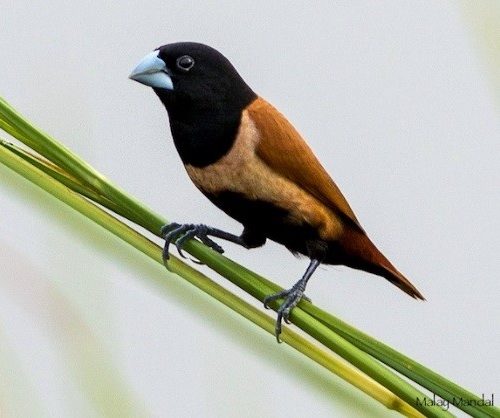
Tricolored Munia, cinnamon variant. (Rajarhat, Kolkata, West Bengal, India; July 5, 2015.) © Malay Mandal
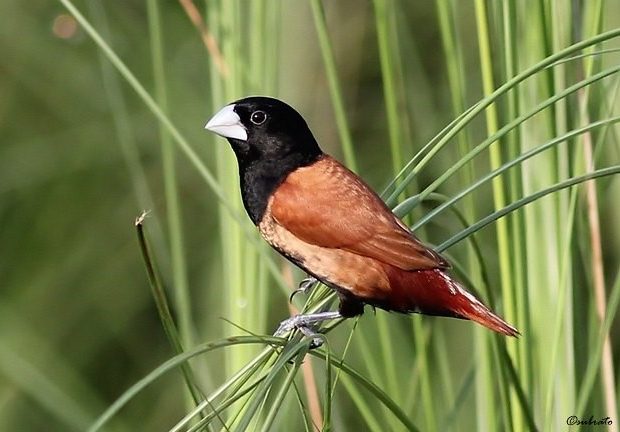
Tricolored Munia, cinnamon variant. (Barasat, North 24 Parganas, West Bengal, India; August 8, 2014.) © Subrato Sanyal

Tricolored Munia, cinnamon variant. (Barasat, North 24 Parganas, West Bengal, India; April 26, 2016.) © Subrato Sanyal
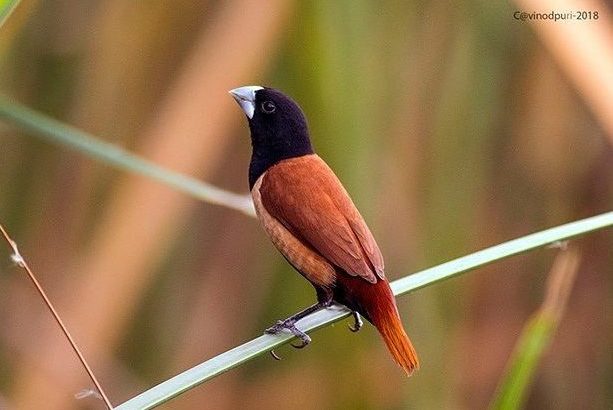
Tricolored Munia, pinkish variant. (Akheraj Swamp, Jodhpur, Rajasthan, India; August 5, 2018.) © Vinod Puri Goswami
Immature plumages are similar to those of several other munias, warm-brown above and buffy below, some rustier and some more neutral brown. They typically show a very subtle version of the adult’s hood, most noticeable as a color contrast on the chest.

Tricolored Munia, immature—note faint hood. (Abhera Wetland, Kota, Rajasthan, India; October 12, 2016.) © Sunil Singhal

Tricolored Munia, immature. (Abhera Wetland, Kota, Rajasthan, India; October 11, 2013.) © Sunil Singhal

Tricolored Munia, immature. (Abhera Wetland, Kota, Rajasthan, India; October 12, 2016.) © Sunil Singhal

Tricolored Munia, immature molting into adult plumage. (Baruipur, South 24 Parganas, West Bengal, India; November 25, 2018.) © Sumit Sengupta

Tricolored Munia, immature, yellow variant—note faint hood. (Sholinganallur / Perumbakkam Marshlands, Kancheepuram, Tamil Nadu, India; January 16, 2018.) © Karthikeyan Ponnambalamoorthy
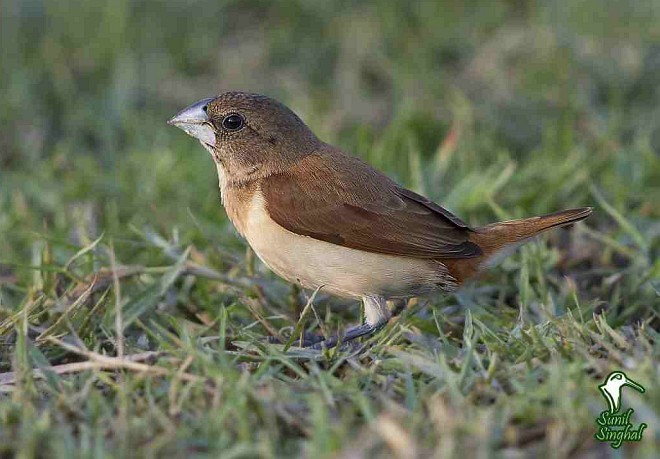
Tricolored Munia, immature—note faint hood and warm-brown wings and tail. (Abhera Wetland, Kota, Rajasthan, India; October 12, 2016.) © Sunil Singhal
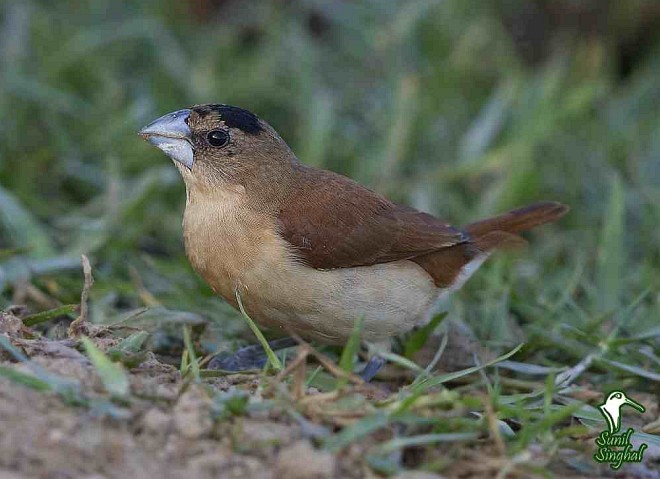
Tricolored Munia, immature molting into adult plumage. (Abhera Wetland, Kota, Rajasthan, India; October 12, 2016.) © Sunil Singhal
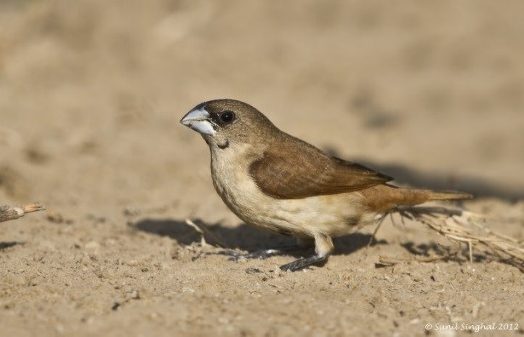
Tricolored Munia, immature. (Abhera Wetland, Kota, Rajasthan, India; October 28, 2012.) © Sunil Singhal
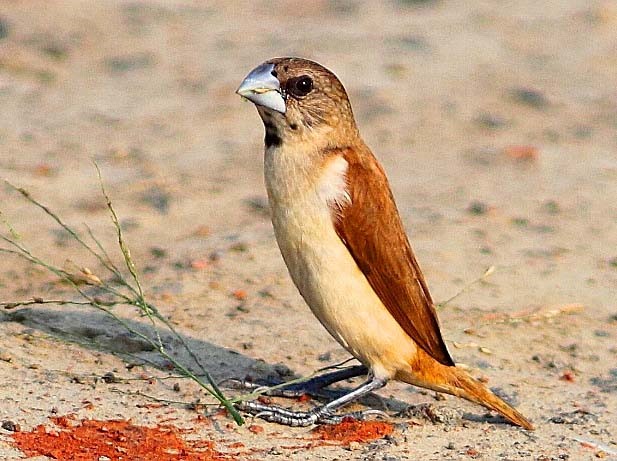
Tricolored Munia, immature, an exceptionally rusty-looking individual molting into adult plumage. (Baruipur, South 24 Parganas, West Bengal, India; November 4, 2018.) © Prosenjit Singha Deo

Tricolored Munia, immature, a colder shade of brown than most. (Chambal River, Kota, Rajasthan, India; November 10, 2012.) © Sunil Singhal

Tricolored Munia, immature—note faint hood. (Nuwara Eliya, Sri Lanka; November 17, 2013.) © Mapalagama K. Premasiri
Voice. Most of its vocalizations are very quiet to human ears. Alarm calls are audible, metallic monosyllables. The flight call is described as a triple chirp.
Cf. Chestnut Munia. Some variants of Tricolored Munia are very similar to some Chestnut Munias. They occur together in West Bengal, western Bangladesh, formerly and perhaps still westward on the Ganges River plain in northern India and Nepal (where Tricolored has apparently displaced Chestnut), in northwestern South America (western Ecuador and Colombia), and possibly on some Caribbean islands—though most if not all recently documented records from the West Indies appear to be Tricolored.
Both species vary but in different ways, and an understanding of their variations enables reliable identification of the vast majority of apparently intermediate individuals. In such cases the key features are the belly pattern and coloration of the flanks.
In general: (1) Tricolored has a specific belly pattern that is nearly invariable, whereas Chestnut’s belly pattern is highly variable; and (2) Chestnut’s flanks and upperparts are almost always concolor, or nearly so, whereas Tricolored almost always has flanks that are distinctly paler than its upperparts.
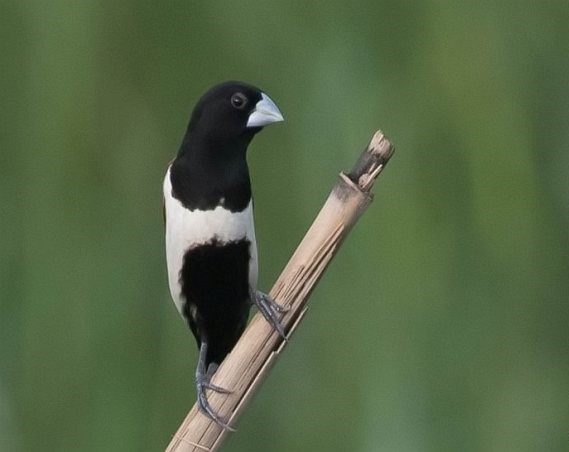
Tricolored Munia, showing its characteristic underparts pattern and coloration. (Yamuna Khader, Wazirabad, Delhi, India; July 23, 2017.) © Rajesh Kalra

Tricolored Munia, showing its characteristic underparts pattern, but atypical coloration. (Rajarhat, North 24 Parganas, West Bengal, India; October 27, 2018.) © Shekar Vishvanath
Belly Pattern: Tricolored Munia consistently shows a crisply defined black belly. The rest of its underparts (i.e., the flanks, sides, and breastband) are typically white, but can also be any of a range of other colors including yellow, tan, cinnamon, rufous, and several shades in between. The width of the breastband is also consistent at about the same width as the bill (although posture can affect this appearance).
Chestnut Munia varies widely in belly color and pattern, both regionally and individually. In atricapilla, the subspecies that occurs naturally with Tricolored, very few individuals, if any, show the same belly pattern as Tricolored. Many have a black belly, but in most cases Chestnut’s belly patch is not crisply defined—instead it typically blurs from black to blackish to chestnut.
Note that some subspecies of Chestnut—mainly jagori of the Philippines and Indonesia—can show a crisply defined black belly, but the shape and extent of the patch usually differs and these subspecies rarely, if ever, overlap with Tricolored.
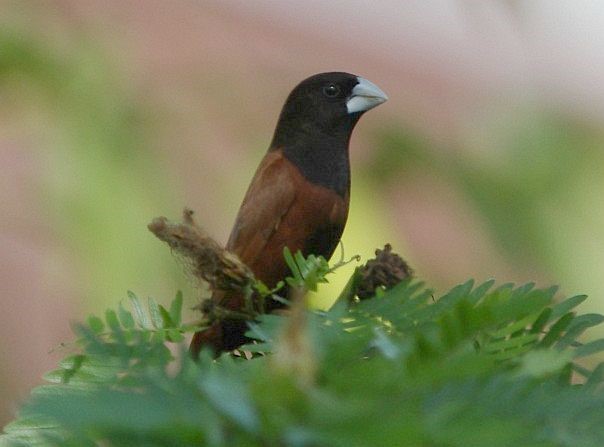
Chestnut Munia, L. a. jagori, a dark-brown individual with a characteristically blurry-edged blackish belly. (Tambun, Sulawesi, Indonesia; September 8, 2005.) © David and Nancy Massie
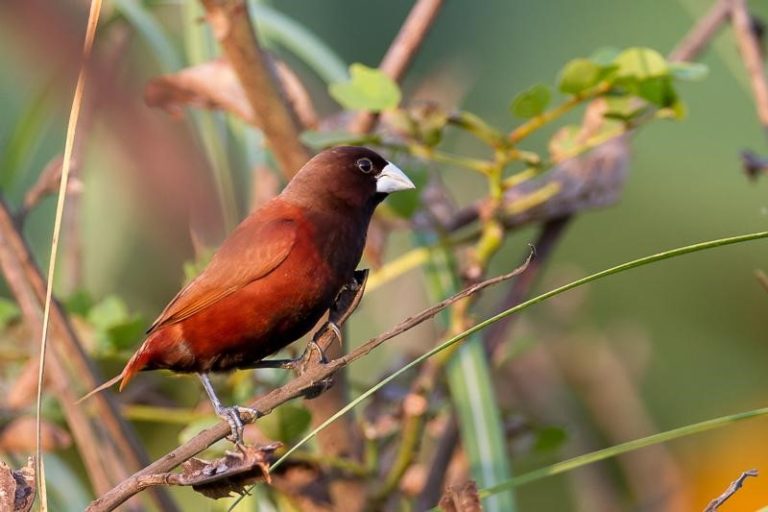
Chestnut Munia, L. a. formosana, with brown hood and blurry-edged blackish belly patch. (Luzon, Philippines; April 2, 2013.) © Paul van Giersbergen
In cases of potential confusion, a crisply defined black belly patch usually indicates Tricolored. When Chestnut shows a similarly well-defined belly patch (as in the photo below) it is often more extensive or otherwise different from Tricolored’s characteristic pattern.
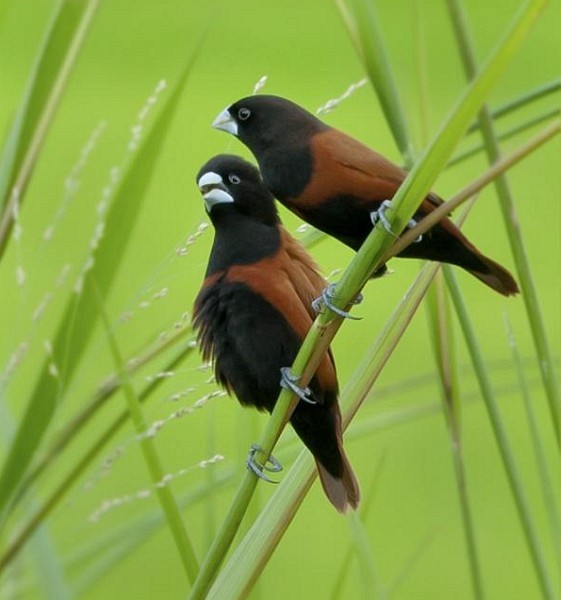
Chestnut Munia, L. a. jagori—the belly patch is well-defined, but very extensive, making the breastband narrow—and this location is far out of Tricolored’s range. (Penampang, Sabah, Borneo, Malaysia; January 13, 2013.) © Sarah Lim
Flank Coloration: On Chestnut Munia, the flanks and upperparts are consistently concolor, within a few shades of each other. Most are chestnut or rufous, some are other shades of brown, but the flanks and upperparts match.
On Tricolored Munia, the flanks and upperparts rarely match. Instead, the upperparts are usually bright chestnut or another rusty shade of brown and the flanks are distinctly paler. (As noted above, the flanks are typically white but can be yellow, tan, cinnamon, rufous, and several shades in between.)

Chestnut Munia, L. a. atricapilla—note concolor flanks and underparts—the belly patch is well-defined, which suggests Tricolored, but it would be out of range. (Jorhat, Assam, India; June 4, 2011.) © Raj Kamal Phukan
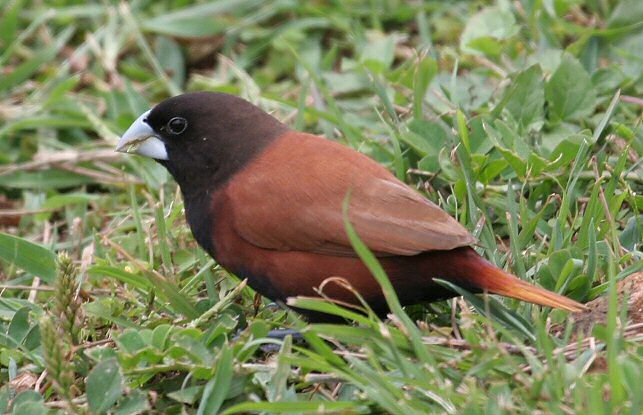
Chestnut Munia, L. a. formosana, showing characteristically concolor flanks and upperparts—this individual also has a brownish hood, which is rarely, if ever, seen on Tricolored. (Wailua, Kauai; April 6, 2005.) © William Hull

Tricolored Munia, cinnamon variant, showing characteristic contrast between upperparts and much paler flanks. (Barasat, North 24 Parganas, West Bengal, India; September 4, 2013.) © Subrato Sanyal

Tricolored Munia, unusual pinkish variant—note contrast between upperparts and much paler flanks. (Akheraj Swamp, Jodhpur, Rajasthan, India; August 5, 2018.) © Vinod Puri Goswami
Double Positives: In a few cases, a confusing Tricolored / Chestnut Munia has both a crisply defined black belly and a match or near-match between the upperparts and the flanks.
Some of these individuals may be hybrids, some may be naturally aberrant. In most such cases, other factors will tend to indicate one species over the other, but perhaps not definitively. (See examples below.)
In cases of potential confusion, contrastingly pale flanks almost always indicates Tricolored, and a close match between the upperparts and the flanks almost always indicates Chestnut.
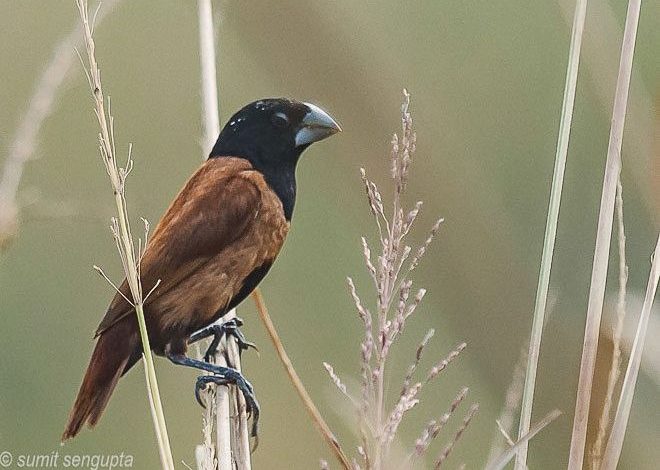
Tricolored Munia—likely, based on well-defined belly patch—in this photo, the flanks appear only slightly paler than the upperparts. (Baruipur, South 24 Parganas District, West Bengal, India; November 25, 2018.) © Sumit Sengupta

Chestnut Munia—likely, based on blurred belly pattern and concolor upperparts and flanks. This individual is unusually pale and was identified as a cinnamon morph Tricolored. (Esmeraldas, Ecuador; January 27, 2014.) © Nick Athanas

Chestnut Munia, L. a. atricapilla—likely, based on overall coloration and blurred belly patch. In this photo, the flanks appear somewhat paler than the upperparts, but part of this impression is due to strong lighting. (Bosipota, Hooghly, West Bengal, India; December 30, 2018.) © Atanu Modak
Notes
Monotypic species. Formerly considered conspecific with Chestnut Munia, together comprising the Black-headed Munia (L. malacca).
Frontiers of Taxonomy: Tricolored and Chestnut Munias.
The relationship between Tricolored and Chestnut Munias (Lonchura malacca and L. atricapilla) has been fraught with confusion and some disagreement remains over their taxonomic status. The ornithological literature lumped them together as the Black-headed Munia (L. malacca) during most of the 1900s. Since the mid-1990s the trend has been to recognize them as separate, following Robin Restall, who wrote the most comprehensive reference work on munias worldwide (Munias and Mannikins, 1996). But several sources of confusion remain—most emanate from India, where both species (or forms) are native:
A portion of the Tricolored Munia population is variably intermediate in appearance. Most of these birds show the pattern of Tricolored but the coloration of Chestnut—and in some cases field identification is difficult. Individuals that fit this general description apparently occur to some extent throughout Tricolored’s range, but they may be more numerous in areas of potential overlap with Chestnut. Some of these intermediate birds may be hybrids (or back-cross descendants of hybrids) but most are merely color morphs of Tricolored.
Many authoritative references in India continue to treat Tricolored and Chestnut as a single species. Some add to the confusion by using the name Tricolored Munia to refer to the collective. As a result, many observers there do not attempt to differentiate between them in their field observations.
Tricolored Munia has apparently expanded its range north across a broad region of the Indian subcontinent (essentially throughout the Ganges River plain), and now occupies a large area that was formerly occupied by Chestnut Munia, apparently out-competing and replacing it. As a result, most references to the distributions of the two species do not reflect their current status.
Restall has argued for separating Tricolored and Chestnut Munias based on, among other factors, differences in vocalizations and the gape patterns of nestlings. As both species are often kept as cage birds, sometimes together in aviaries, Restall also cites the experience of aviculturalists who report that Tricolored and Chestnut self-segregate when given the opportunity. Assortative breeding has also been reported in the wild in both native and introduced populations.
In addition, the apparent displacement of Chestnut Munias by Tricolored along the Ganges is facial evidence that the two species do not simply blend into a common gene pool when they come into contact. Instead, it appears that one form out-competes and eliminates the other, which is consistent with their being different species that remain genetically intact and have divergent adaptive success.
The existence of apparently intermediate individuals is the original source of confusion over the status of Tricolored and Chestnut Munias, and it causes three persistent problems. First, it appears to be facial evidence of hybridization, which suggests that the two are a single species and therefore not reliably distinguishable, so few observers make the effort. Second, the intrinsic variation within both species is not well depicted in field guides, so there is no adequate reference to help observers reliably identify apparently intermediate individuals. Third, the lack of clarity leads to inconsistent field identification of those apparently intermediate individuals, so a large portion of observer reports are simply unreliable.
The field identification problem is best solved by a study of the intrinsic variation in both species. With this knowledge, most clearly observed individuals can be reliably identified. For an account of their variation and guidance on some consistent distinctions to differentiate them in the field, see above.
References
Anonymous. Lonchura malacca (Linnaeus, 1758). India Biodiversity Portal. https://indiabiodiversity.org/biodiv/species/show/239872. (Accessed August 28, 2018.)
Ascanio, D., G.A. Rodriguez, and R. Restall. 2017. Birds of Venezuela. Christopher Helm, London.
Brazil, M. 2009. Birds of East Asia. Princeton University Press, Princeton, N.J.
eBird. 2019. eBird: An online database of bird distribution and abundance. Cornell Lab of Ornithology, Ithaca, N.Y. http://www.ebird.org. (Accessed July 5, 2019.)
ffrench, R. 2012. A Guide to the Birds of Trinidad & Tobago (Third Edition). Cornell University Press, Ithaca, N.Y.
McMullan, M., and T. Donegan. 2014. Field Guide to the Birds of Colombia (Second Edition). Fundación Proaves de Colombia. Bogotá.
Payne, R. 2019. Tricoloured Munia (Lonchura malacca). In Handbook of the Birds of the World Alive (J. del Hoyo, A. Elliott, J. Sargatal, D.A. Christie, and E. de Juana, eds.). Lynx Edicions, Barcelona. https://www.hbw.com/node/61194. (Accessed July 5, 2019.)
Raffaele, H., J. Wiley, O. Garrido, A. Keith, and J. Raffaele. 1998. A Guide to the Birds of the West Indies. Princeton University Press, Princeton, N.J.
Restall, R. 1997. Munias and Mannakins. Yale University Press, New Haven.
